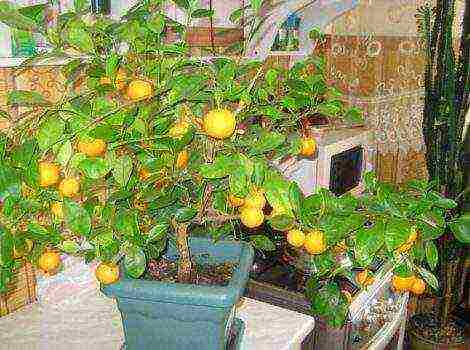Content
- 1 Selection and preparation of seeds
- 2 Soil requirements
- 3 Seed sowing technology
- 4 Seedling care
- 5 Temperature control and lighting
- 6 Pick and pinch
- 7 Video "Growing geraniums from seeds"
- 8 History and interesting facts
- 9 Description
- 10 Reproduction of room geranium
- 11 Reproduction of garden geranium
- 12 When can you sow seeds?
- 13 How to accelerate seed germination?
- 14 Which soil to choose?
- 15 How to sow seeds?
- 16 Care of young geranium bushes
Pelargonium from seeds at home can be grown not only by specialists. In order to decorate windowsills or facades of houses with lush flowering plants, you just need to know how to grow geraniums from seeds. It is this way of reproduction that produces especially healthy and beautiful specimens.
Selection and preparation of seeds
It is not difficult to grow pelargonium from seeds, knowing the basic rules. Geranium seeds can be bought at the store, and if you propagate the species that is already growing at home, then after the flowers have bloomed, they must be left alone so that they form fruits. Pelargonium seeds are allowed to mature fully before harvesting. Then we collect the ripe seeds and examine them. Large specimens of a dark brown color are suitable for sowing, some of them may be dull or slightly different in shades, but there should be no spots.
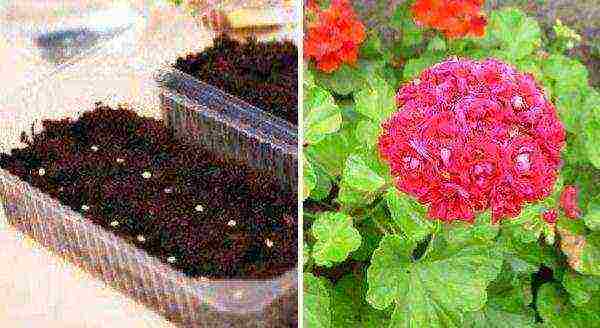
Oblong brown seeds with depressions on the sides are covered with a very dense skin. So that it does not delay germination, the planting material is specially prepared. The seeds are scraped with a knife or stroked several times on both sides with fine sandpaper, making it easier for the future sprout. Then they are soaked for several hours in warm water (some growers before that keep the seeds for 20-30 minutes in a solution of potassium permanganate or "Epin"), then they are dried.
Soil requirements
Pelargonium is grown from seeds in loose nutrient soil with low acidity. Geranium grows wonderfully in breathable, moist soil that does not retain excess water. It can be purchased at the store or made up yourself to avoid excessive mineralization. It can consist of turf and peat with sand; peat with perlite is a good mixture.
Before planting geranium (its seeds), the earth must be disinfected. To do this, it is enough to hold it in a preheated oven for 20 minutes or pour it over with a hot solution of potassium permanganate. Some people advise using fungicides. It is advisable to plant one day after the procedure.
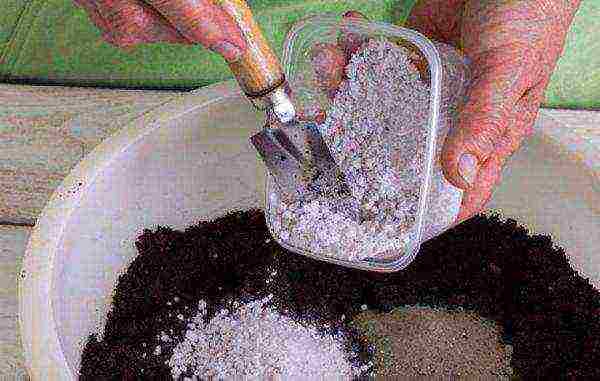
For growing geraniums at home with seeds, use a shallow (no deeper than 3 cm) wide dishes with drainage holes. A layer of expanded clay is placed on the bottom, and soil is placed on top. Moisten it before planting.
Seed sowing technology
Planting geraniums with prepared seeds can be carried out all year round, but it is best to do this from February to April - it turns out to wait for flowering as soon as possible. You don't need to plant geraniums too often. Between the seeds, leave from 2 to 4 cm so that the roots do not intertwine. Seeds are laid out on a wet surface of the soil, lightly pressed with your fingers, sprinkled with loose soil on top (its layer should be no more than 1 cm thick). Then the surface is moistened with a spray bottle, covered with a transparent lid, glass or plastic wrap to create a greenhouse effect.
The seeds planted in this way are placed in a warm room with an air temperature of + 22 ... + 24 ° C. Illumination at this stage does not matter.Crop care consists in airing and moistening, it is important to monitor the temperature level.
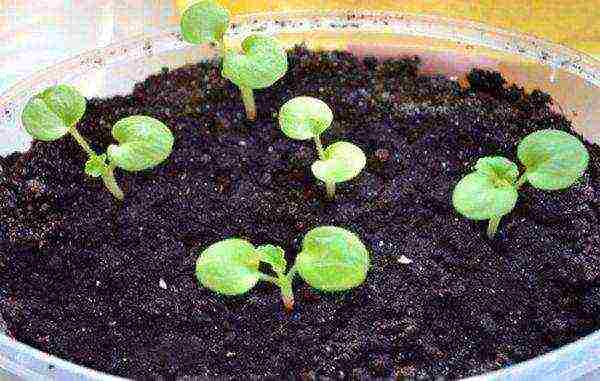
Different types of pelargonium take different times to germinate. The zonal geranium can germinate in a week, and the royal sprouts will have to wait at least 3 weeks. Immediately after the emergence of seedlings, the film is removed, and the dishes are exposed to light.
Seedling care
Growing geraniums from seeds at home involves quite traditional care: the seedlings need to be kept in comfortable conditions, watered and fed regularly. For irrigation, use settled (soft and clean) water at room temperature. Watering with a watering can with a long spout, moistening the ground, not the plants - geranium does not like spraying and any contact of leaves with water. This is done about 2 times a week, but a more accurate schedule determines the rate of drying of the top layer of the earth.
Starting from the age of two weeks of seedlings, it is recommended to feed it with mineral fertilizers containing potassium and phosphorus. You can sometimes pour with iodine solution. Top dressing is carried out in 2-3 weeks at the same time as watering.
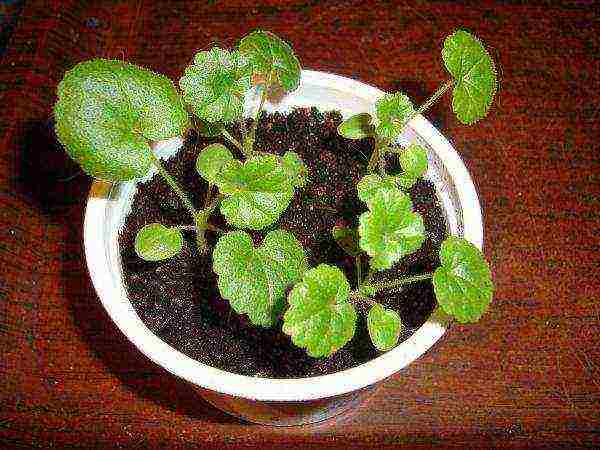
It is important to monitor the looseness of the soil: it must be carefully loosened between waterings so that the roots receive the right amount of air, and excess water does not accumulate.
Temperature control and lighting
Geranium does not require special conditions of keeping, it is satisfied with the air temperature in a wide range from +20 to +30 ° C, in winter it should not fall below + 10 ... + 15 ° C. Seedlings grown from seeds are best kept on the windowsill on the east or west side. She needs a daylight hours of at least 16 hours, but direct sunlight can burn delicate leaves, so the plants will have to be slightly shaded from the south side.
In the spring, young plants are planted outside, but even there, in order for the geranium to bloom more luxuriantly, it is advisable to keep it in partial shade.
Pick and pinch
Growing pelargonium from seeds requires a mandatory pick after the appearance of 2-3 true leaves. This is necessary for the full development of the root system. Each plant is carefully removed from the common dish and transplanted into separate pots or tall cups with a diameter of 10 cm.

The basic requirements for the soil are the same: looseness, nutritional value, weak acidity.
At the bottom, a drainage layer must be arranged. Further, the plants are looked after as adults. You need to replant when the pot becomes cramped. It is better to transplant from the beginning of spring, when growth is activated.
To form a beautiful ornamental plant, it is usually recommended to pinch it after every 5-8 leaves (depending on the species and variety). This should be done with clean hands or tools; it is advisable to treat the cut site with activated (charcoal) carbon. Pelargonium should be lush, but breathable and transparent.
Video "Growing geraniums from seeds"
In this video, you will learn how to grow pelargonium from seeds on your own.
Pelargonium, or simply geranium, is one of the most popular among lovers of home and garden plants. And this is not surprising at all, because it is a pleasure to grow it: it has excellent decorative properties and is very unpretentious in care. Knowing some of the rules and features of geraniums, even an inexperienced florist can cope with its reproduction.
Geranium
History and interesting facts
Geranium is a perennial or annual plant belonging to the geranium family, which has more than 400 species and forms. Its homeland is hot South Africa, but pelargonium grows almost throughout the Northern Hemisphere, in regions with a temperate climate and mountainous subtropical regions. In Europe, it appeared in the 15-16th century, and immediately fell in love with flower lovers. The name "geranium" comes from the Greek word "geranos", which means crane.
Pelargonium
It should be noted that this beautiful plant is grown not only for decorative purposes.It has many beneficial properties: it can neutralize toxins and harmful substances, relieve headaches, and also stop bleeding and heal wounds. It is recommended to keep geranium in rooms where hypertensive patients live, as well as people suffering from nervous system disorders and insomnia.
Pelargonium zonal
In the old days, pelargonium was endowed with not only healing, but also mystical properties. It was believed that this plant scares away snakes, so it was planted around houses in those places where reptiles are found in large numbers. In addition, fragrant sachets are often made from pink geranium flowers and placed next to worn things - in order to protect themselves from the evil eye, and at the same time scare away moths. But cat lovers with this plant should be careful. As you know, cats love to feast on home flowers, and the leaves of pelargonium contain poisonous substances that are extremely dangerous for animals.
Red blooming geranium
Description
Geranium is a low herb or shrub with a branched root system (except for species that grow in the mountains - their root looks like a rod). The structure and color of the leaves in different species also differ from each other - they can be green, grayish, bluish or even red, whole, with small or pronounced cuts, and in many varieties the leaves are covered with hairs.
Indoor geranium
The flowers of pelargonium are large enough, have a blue, white, purple or purple hue, collected in inflorescences that look like a brush. The fruits in which the seeds ripen (this happens in late summer and early autumn) are capsule-shaped, with long valves - after ripening, they twist, scattering the seeds.
Geranium seeds
Reproduction of room geranium
Indoor white geranium
Before growing indoor geraniums, you should know several important rules:
- the best place for a pot is a well-lit windowsill, since the plant loves sunlight very much;
- in winter, it is better to keep the flower in a cool room, but the temperature should not be lower than 10 ° C;
- in order to increase the number of shoots and inflorescences, the plant should be pinched, and dried flowers should be removed;
- almost all types of pelargonium must be cut regularly;
- with sufficient nutrition and lighting, the flower can bloom throughout the year.
Growing from seeds
Seeds - photo
Red, white, fragrant, as well as ampelous pelargonium grows best in indoor conditions. Before starting planting, you should make sure that the seeds are free of hard leathery shells. Otherwise, they will need to be well sanded with sandpaper. Experienced flower growers do not name the exact time for planting, since with sufficient lighting, seedlings can grow in autumn and winter, but the period from November to April is considered the optimal time.
The surface of the seeds must be scratched with a knife or rubbed with an emery stone
- Before sowing, the seeds should be prepared in a certain way: treated with zircon or epinin, and soaked for three hours, no more, in water at room temperature.
By the way, for the prevention of various diseases, you can first hold the seeds in a solution of potassium permanganate for 20 minutes, and then rinse and soak in plain water
Seed treatment
- Take containers or boxes that are filled with a mixture of turf with sand and peat (2: 1: 1) or a peat-perlite mixture (1: 1) - this is the substrate that is best suited for growing seedlings.
Prepared pots with soil
- Spread the seeds at a distance of at least five centimeters, sprinkle a little and cover with plastic or glass. Spray the soil constantly from a spray bottle with pre-settled water at room temperature and make sure that it does not dry out.
- If the temperature and humidity conditions are correct, the sprouts will appear in two weeks.
The first shoots under the film
- The transplant is carried out when 2-4 sprouts appear on the seedlings. It is very important not to miss this moment, as the roots will intertwine and it will be very difficult to transplant. The pots must be at least 10 cm.
Sprout transplant
Room geranium care
Despite the fact that geranium loves moisture, it should not be in stagnant water, so a layer of expanded clay should be poured onto the bottom of the pot. Water the plants with a narrow-nosed watering can. As soon as 6-7 leaves appear on the plant, it must be pinned to stop its growth and "awaken" the lateral buds. On cloudy days, Pelargonium must be provided with additional lighting. In summer, it is better to take it outside and put it in a place protected from direct exposure to ultraviolet rays (the plant loves warm, dry air).
How to care for room geraniums
You need to fertilize the flower once every two weeks, starting from the end of March until November, using liquid fertilizers for this. In addition, you can prepare top dressing yourself: for this, a liter of water is taken, to which a drop of iodine is added. You need to take 50 ml of this solution, and gently water the plant with it so that the liquid does not fall on the roots, but on the walls of the pot. Geranium does not need spraying.
Geranium care
Pelargonium is susceptible to a number of diseases, therefore, the plants should be regularly examined for the appearance of characteristic signs. These can be yellowed leaves, reddened leaves, gray mold, or leaf fall. Usually the reason for such phenomena is too low room temperature or excess moisture. The most dangerous disease for geraniums (especially for young shoots) is called "black leg". In this case, the base of the stem begins to darken in the plant - unfortunately, there are no radical methods of combating this phenomenon, so the infected specimens will have to be destroyed.
Geranium diseases
Reproduction of garden geranium
When choosing a place for growing garden geraniums, it is very important to take into account the characteristics of the variety. Most plants prefer sunny or semi-shaded places, but there are some that can only grow near bodies of water. So, in dry, sunny places, red-brown, Georgian and large-flowered species grow well, in the shade - Balkan pelargonium, in wet and shaded areas - Himalayan, marsh and meadow. The soil should be slightly acidic or neutral and fertile enough.
Garden geranium
You can propagate garden geraniums both by seeds and vegetatively. The first one is rather laborious; in addition, in this case the varietal characteristics of the plant are not always preserved. In addition, it is difficult to collect seeds, and some species do not form them at all. To prevent the seeds from scattering around the site, experienced gardeners do the following: they make small canvas bags in which they place the unripe fruits of the plant, and fix them well - if the fruit bursts, the seeds will be trapped in a kind of trap. It should also be borne in mind that plants that are propagated with seeds bloom only next year.
Garden geranium seeds
To plant geraniums, seedlings can be grown from seeds in the same way as in the case of room geraniums, and then transplanted into open ground, or simply sowed into soil fertilized with peat.
Transplants
Seedling before transplanting into the ground
It is important that the planting site is large enough, since geraniums tend to grow strongly. It is also worth considering that heat-loving plant varieties do not like direct sunlight (they can severely burn the leaves), so a lace shade is best for them - for example, under the crowns of trees. Planting sprouts or sowing seeds is best done in spring or late summer.
How to propagate geranium by cuttings
Garden geranium care
The rules for caring for garden pelargonium are quite simple, and are as follows:
- the most important thing is regular watering in accordance with the requirements of a particular variety;
- in order not to loosen the soil, it is better to plant low-growing garden crops between the bushes of the plant, or to mulch the soil;
- rejuvenation or transplantation of pelargonium does not require at least ten years;
Geranium care consists of regular watering and fertilization
- removal of weeds is also not necessary - geranium grows almost immediately, so there is simply no room for weeds;
- in autumn, they are pruned on the bushes, with the exception of winter-green species, which can winter without pruning and shelter;
- in the spring, as soon as the plants wake up (usually this happens early enough), the planting needs to be fed with nitrogen fertilizer, and after about thirty days - with a complex one;
- do not work with geraniums in too hot weather - it releases a large amount of oils that can irritate the skin on the hands.
An open and lighted place like garden geranium
Diseases and pests
Pelargonium is practically not subject to spoilage by pests, since the strong aroma of its leaves repels insects. The only exception is spider mites, which can be eliminated with a soapy solution or insecticide. As for diseases, they most often appear if geranium grows in cold, too humid places. Some of the most common plant diseases include:
- powdery mildew. The first sign is a white bloom on the leaves, after which they begin to dry out, and the geranium dies. As a control measure, the infected parts must be removed, and the bush must be treated with a Bordeaux mixture;
Bordeaux mixture
- gray rot. It manifests itself as brown spots on the leaves, which subsequently grow, and the leaves begin to curl and fall off. A diseased specimen should be removed immediately so that it does not infect the rest;
Gray rot on geranium leaves
- brown spot. Light spots form on the underside of the leaves, which then turn yellow or brown. The disease can be eliminated with a fungicide.
Alirin-B
Beauty geranium is an easy-to-care, unpretentious plant that will appeal to both a beginner and an experienced florist. It can be planted on a balcony, in a garden, in flower beds or at home - in any case, its bright flowers and thick leaves will become a real decoration.
Beautiful sunny flower - geranium (pelargonium)
Video - Caring for geraniums at home
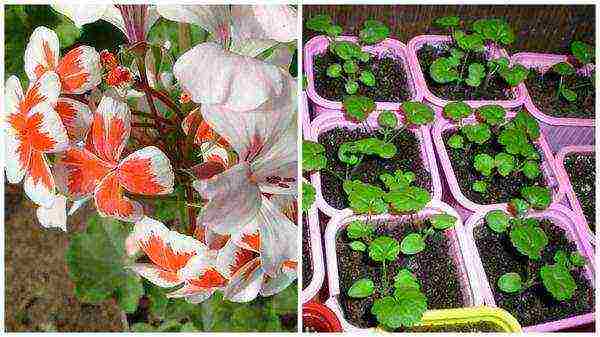 The favorite of flower growers, geraniums are easiest to propagate by cuttings - this is the simplest and most reliable method, which in 99% of cases gives positive results. But when it comes to rare varieties that are difficult to find on the shelves of flower shops in adult form, the seed method of growing comes in handy. The selection of seeds is always good enough, and with a little effort it is quite possible to obtain a rare variety of geraniums.
The favorite of flower growers, geraniums are easiest to propagate by cuttings - this is the simplest and most reliable method, which in 99% of cases gives positive results. But when it comes to rare varieties that are difficult to find on the shelves of flower shops in adult form, the seed method of growing comes in handy. The selection of seeds is always good enough, and with a little effort it is quite possible to obtain a rare variety of geraniums.
When can you sow seeds?
The time for sowing geraniums depends on desire and lighting. If it is possible to provide backlighting or there is enough natural light in the room, you can grow pelargonium at least year-round.
According to the recommendations and observations of experienced flower lovers, the best time for sowing seeds is considered to be the period from late autumn to mid-spring.
How to accelerate seed germination?
In order for the seeds to sprout faster, it is necessary to carry out scarification, that is, to violate the integrity of the shell. This can be done in two ways:
- Place the seeds in a clay pot and rub them lightly with an emery stone.
- Use a sharp knife to scrape off the brown shell from one side of the seed.
Soak the prepared seeds in water for a day.
Which soil to choose?
For successful germination of geranium seeds, the substrate must be loose. Ordinary garden soil will not work here, it is better to use lighter components for this purpose, such as peat and perlite in a 1: 1 ratio.
The best option is also a soil mixture, which includes:
- 2 pieces of turf;
- 1 part peat;
- 1 part sand.
How to sow seeds?
It is good to shed soil before sowing. Lay out the seeds, leaving a distance of 5 cm between them and lightly sprinkle on top. To maintain the humidity and temperature required for germination, the pot must be covered with foil.
Spray the soil in the pot periodically to prevent it from drying out.
After one and a half to two weeks from the moment of sowing, shoots will appear, then the film can be removed. After another week, they can be dived into separate containers. At this stage, each seedling should have at least 2-4 leaves. Before removing the seedlings, the soil should be well moistened so as not to damage the fragile young roots in the process.
Care of young geranium bushes
The first feeding of geraniums must be carried out 2 weeks after transplantation. In the future, it is enough to apply fertilizers twice a month, using complex preparations with a low nitrogen content, otherwise the geranium will refuse to bloom.
When a young bush grows more than 6 leaves, pinch the top of the shoot - this way you can form a compact flower and achieve active flowering.
Video about growing geraniums from seeds
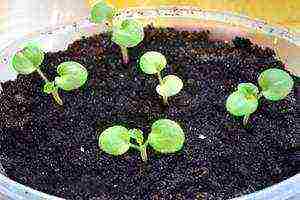 Pelargonium or, as it is also called, geranium is an indoor plant that does not require special care. Pelargonium can decorate not only your room, but also a balcony, terrace or flower bed in the garden. Growing geraniums from seeds at home is not so difficult. Let's take a closer look at the features of growing pelargonium from seeds at home, as well as how to grow geraniums in the summer in the open field.
Pelargonium or, as it is also called, geranium is an indoor plant that does not require special care. Pelargonium can decorate not only your room, but also a balcony, terrace or flower bed in the garden. Growing geraniums from seeds at home is not so difficult. Let's take a closer look at the features of growing pelargonium from seeds at home, as well as how to grow geraniums in the summer in the open field.
Features of growing pelargonium
You should immediately pay attention to the fact that only the so-called zonal geranium can be grown from seeds. Other types of pelargonium reproduce a little differently. Particular attention should be paid to the selection of pelargonium seeds. In order to avoid possible mistakes, it is necessary to carefully select and prepare the planting material. In this case, you should pay attention to the following nuances:
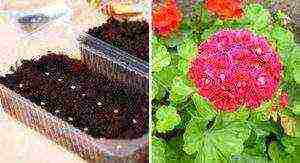 Seed color. Good plant seeds have a rich brown color. Only slight dullness and light shade are allowed.
Seed color. Good plant seeds have a rich brown color. Only slight dullness and light shade are allowed.- Seed shape. It is recommended to use seeds of an oblong shape; slight depressions should be visible on their sides.
- Seed size. Geranium seeds should be large enough.
- Seed shell. This planting material is characterized by the presence of a dense leathery shell.
If pelargonium seeds have all of the above qualities, then they can be used for sowing. Avoid buying small, flattened, misshapen, or spotted seeds.... Planting such material will not give any good result..
Pre-treatment of seeds before growing
 As mentioned earlier, the planting material of geraniums has a rather dense shell, which can make it difficult for their germination. Sometimes the waiting times for plant sprouting are quite long, but the seeds still do not germinate... The reason for this lies in the improper processing of the planting material, or even in the absence.
As mentioned earlier, the planting material of geraniums has a rather dense shell, which can make it difficult for their germination. Sometimes the waiting times for plant sprouting are quite long, but the seeds still do not germinate... The reason for this lies in the improper processing of the planting material, or even in the absence.
That is why, before planting, pelargonium seeds must necessarily undergo scarification, which means removing a dense film from the seeds. This procedure can be carried out on its own, it's pretty straightforward. To do this, you need to take fine sandpaper, with its help remove only the upper dense layer from the planting material. At the same time, deep breaks do not remain on the seeds.Processing should be carried out separately over each seed, rubbing it against sandpaper several times.
Soil selection
Pelargonium will thrive in a light nutrient mixture that allows water and air to flow well to the plant's root system. For planting seeds you can use ready-made store-bought primer, but you can also make it yourself. Let's consider several options:
- Peat, humus, sand and compost are mixed in equal parts.
- Two parts of the garden land are combined with one part of peat and sand.
- Peat is diluted with perlite in a one-to-one ratio.
If you have the opportunity to prepare the soil for planting seeds on your own, then this opportunity is recommended to use. It is worth paying attention to the fact that shoots will appear in the purchased soil much later, the seedlings will be weaker, and the bush forms thin stems. Flowering in purchased soil will be rather scarce.
Before sowing seeds in the ground, the substrate must be disinfected in order to avoid further contamination of the plant. For this, it is recommended to fry the substrate for several minutes in the oven. For soil treatment, you can also use ready-made fungicides. high quality or potassium permanganate solution. In this case, planting should be carried out one day after soil treatment.
The most favorable period for sowing seeds is from February to March. If geraniums are planted later, then the plant will stretch out strongly in the future and will bloom only 9 months after sowing.
Sowing
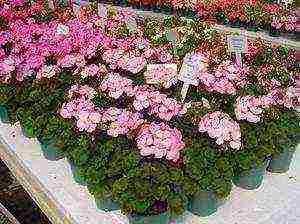 Pelargonium seeds must be sown in shallow containers or bowls, the height of which will not exceed 3 cm. If there are no special containers, then any trays from semi-finished products or other improvised containers may be suitable.
Pelargonium seeds must be sown in shallow containers or bowls, the height of which will not exceed 3 cm. If there are no special containers, then any trays from semi-finished products or other improvised containers may be suitable.- The containers must be filled with a substrate, sprinkled with plenty of water, and then left to warm up. The temperature of the prepared soil should be within 22 degrees.
- After the preliminary preparation, which was described above, the geranium seeds must be soaked in warm water for three hours. This will promote good seedling.
- After that, the seeds must be spread out on the surface of the soil, slightly pressing them into the substrate. Sprinkle the seeds with a thin layer of loose substrate.
- After this disembarkation, it is necessary to cover it with glass or plastic wrap, and take it to a well-lit place. The temperature in the room in which the seedlings are kept should be at least 20 degrees.
The first shoots usually appear a couple of weeks after sowing. After the emergence of seedlings, the containers must be gradually opened. From this time on, it is also necessary to monitor the moisture content of the soil..
Care after germination
In order for geranium to grow into a healthy and strong plant, to form a beautiful bush, it must be well looked after. Caring for geraniums means:
- Timely watering.
- Fertilizers with dressings.
- Regular loosening of the soil.
- Warm indoor climate.
- Pick and pinch.
Watering and feeding
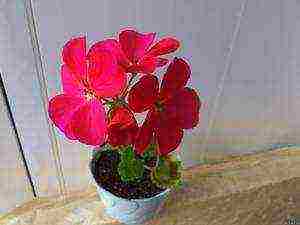 Very often, beginner growers make the mistake of over-wetting the soil, which can lead to an insidious disease called black leg. This disease develops rather quickly and destroys all the seedlings. To avoid this problem, it is imperative to make a drainage layer in the pot for planting, as well as make holes to drain excess water. In addition, the watering regime is very important. Geranium seedlings should be watered only as the soil dries up, trying not to flood them. After picking the seedlings into separate pots, it is recommended to water them no more than twice a week. In winter, the frequency of watering is reduced to 1 time per week.
Very often, beginner growers make the mistake of over-wetting the soil, which can lead to an insidious disease called black leg. This disease develops rather quickly and destroys all the seedlings. To avoid this problem, it is imperative to make a drainage layer in the pot for planting, as well as make holes to drain excess water. In addition, the watering regime is very important. Geranium seedlings should be watered only as the soil dries up, trying not to flood them. After picking the seedlings into separate pots, it is recommended to water them no more than twice a week. In winter, the frequency of watering is reduced to 1 time per week.- As for feeding, the first time it should be carried out 2 weeks after the pick.For this, it is recommended to use fertilizers for flowering indoor plants, which are rich in phosphorus and potassium. Top dressing, as a rule, is carried out every 2 weeks. In winter, feeding stops altogether.
Air temperature and lighting
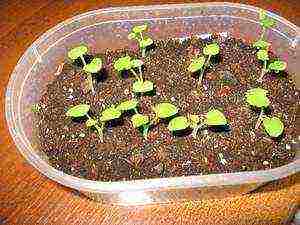 When caring for young seedlings, it is necessary to remember that they need light. It is recommended to place pots or containers with seedlings on the east or west side. If the containers are placed on the south window, then additional shading will be required to avoid direct sunlight, which, even in winter, can harm the delicate foliage of plants.During active growth of pelargonium, as well as during the formation of shoots, the plant should be illuminated for at least 16 hours a day ... If at the same time there is not enough natural light for the plant, then in the evening it is necessary to organize additional artificial lighting. In summer, it is recommended to take geranium pots to the balcony, terrace or garden.
When caring for young seedlings, it is necessary to remember that they need light. It is recommended to place pots or containers with seedlings on the east or west side. If the containers are placed on the south window, then additional shading will be required to avoid direct sunlight, which, even in winter, can harm the delicate foliage of plants.During active growth of pelargonium, as well as during the formation of shoots, the plant should be illuminated for at least 16 hours a day ... If at the same time there is not enough natural light for the plant, then in the evening it is necessary to organize additional artificial lighting. In summer, it is recommended to take geranium pots to the balcony, terrace or garden.- In a room containing pelargonium, it is necessary to maintain an optimal air temperature, which should be at least 20 degrees and not more than 25 degrees. In winter, already an adult plant is able to withstand a short drop in temperature up to 10 degrees. But it is worth paying attention to the fact that for young plants such fluctuations in temperature will become destructive.
Pick and pinch
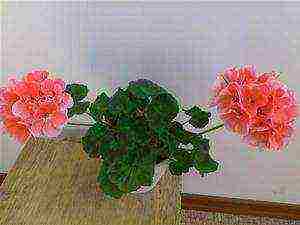 In order for geraniums to have a well-developed root system, it must be kept in separate containers. The picking of young seedlings must be carried out after the appearance of two true leaves. After that, for the purpose of further cultivation, it is necessary to select narrow and rather high pots, the diameter of which will be about 10 cm.If the young geranium seedlings have already stretched a little, then they are allowed to be buried a little in the ground.
In order for geraniums to have a well-developed root system, it must be kept in separate containers. The picking of young seedlings must be carried out after the appearance of two true leaves. After that, for the purpose of further cultivation, it is necessary to select narrow and rather high pots, the diameter of which will be about 10 cm.If the young geranium seedlings have already stretched a little, then they are allowed to be buried a little in the ground.- In order to form a beautiful bush shape, as well as to prevent the plant from stretching, it must be regularly pinched. The first pinching of the plant should be done after the fifth true leaf. In the future, the geranium flower should be regularly pruned in the spring and autumn. During this procedure, all weak and thin shoots are cut out. The formation of the bush stops, as a rule, a month and a half before the start of geranium flowering. Pelargonium blooms at home 3 months after planting.
How to transplant and grow in open ground?
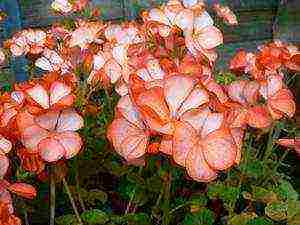 If you have the desire and opportunity, then pelargonium can be transplanted into your own garden. From such plants, you can form a wonderful rabatka. In the open field in a common flower bed in the garden, geraniums will look very good in combination with other plants and flowers.
If you have the desire and opportunity, then pelargonium can be transplanted into your own garden. From such plants, you can form a wonderful rabatka. In the open field in a common flower bed in the garden, geraniums will look very good in combination with other plants and flowers.
Transplanting geraniums into open ground it is recommended to carry out at the end of May. In this case, it is necessary to choose a place with a light partial shade. Thus, geranium flowers will be much larger, and too hot the sun will not harm them. As a rule, in the heat, usually the leaves of pelargonium begin to dry out and turn yellow. When planting geraniums in open ground, you must pay attention to the fact that the plants should be planted at a distance of 30 cm from each other.
The soil for geraniums in the garden should be quite nutritious. You can add leafy humus to it, in a well-rotted form. At the same time, you should not get too carried away with organic matter., since in this case, pelargonium will receive too many nutrients, which can lead to a lack of flowering.
Watering pelargonium in the open field must also be done very carefully. Watering the plant should only be done as needed. Once every two weeks, it is recommended to feed pelargonium with complex fertilizers for flowers.
Well-groomed geraniums are capable of blooming in the open field until autumn. But with the onset of cold, the flower must be dug up and transferred to the house.
To do this, you need to prepare the pots again., but this time they should be slightly larger in diameter, since the root system of the plant develops well in the open field. It is necessary to dig out geraniums from open ground with a large lump of soil, after which the plant is placed in a pot.
After that, in room conditions, pelargonium can bloom for some time, but after this flowering of geraniums, it is necessary to arrange a so-called respite. In this case, all old flower stalks are removed, overgrown shoots are cut off. By the way, you can propagate pelargonium with trimmed shoots. After this, the plants must be placed in a cool and bright place.
With the onset of winter, as a rule, watering is reduced by 2 times, and top dressing is completely excluded. Thus, geranium grown from seed will wait for the coming of a new spring.
In conclusion, it should be noted that the care and cultivation of pelargonium at home is quite a simple matter. It is only necessary to provide the seedlings the necessary care, after which multi-colored beautiful hats will appear on your windowsill. As mentioned earlier, in May, if you have a desire, pelargonium can be planted in your flower bed, where it can delight you and your guests throughout the summer with its abundant flowering.
Pelargonium zonal is a bright and useful pot plant.... She is able not only to decorate your beds, but also to scare off various pests.
>


